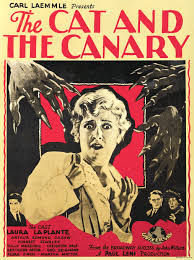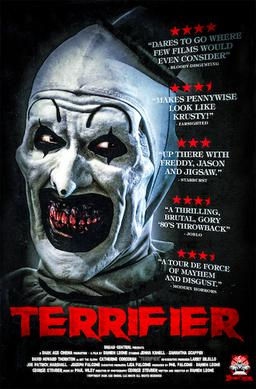The Cat and the Canary (1927) review
- Jeremy Kelly
- Sep 27, 2021
- 5 min read
Welcome, one and all, to my 10th—that’s right, 10th—year of reviewing horror movies. Since Facebook disabled its Notes feature, I’ve had to make adjustments; so for the indefinite future, I will be publishing my reviews on my new blog. In addition, I will be reposting the first nine years of reviews in the near-future, but not before a re-mastering of sorts, in which I spend hours saying to myself, “Good God, I really used to write like that?” It won’t be a complete overhaul, but it will be an earnest attempt to make the style and quality more consistent with how I’ve evolved my reviewing process over time.
I wish I could say I have some kind of special theme to mark this decade milestone, but I decided on a “back to basics” concept instead; last year was all 21st century films, but we’re returning to some of the golden oldies this year—some famous, some not so famous, but all worth talking about. And here’s a first: one of the main characters is played by someone I’ve personally met. Can you guess who it is? Let’s just say they have a memorable face; feel free to leave guesses in the Comments section below.
But we’ll leave all that for later; let’s begin with a purrrfectly satisfactory chiller.
1. The Cat and the Canary (1927)
Directed by: Paul Leni
Produced by: Paul Kohner
Screenplay by: Alfred A. Cohn
Starring: Laura La Plante, Forrest Stanley, Creighton Hale, Flora Finch

After the success of “The Cabinet of Dr. Caligari” and “Nosferatu,” the German Expressionism movement began to make its mark in Hollywood, still a young industry following the Thomas Edison patent wars of the 1910s. One of the more notable names was director Paul Leni, who impressed German-born Universal Pictures president Carl Laemmle with his 1924 anthology chiller “Waxworks,” so much that he invited him to direct an adaptation of the popular John Willard play “The Cat and the Canary.” Following Universal’s production of hits like “The Hunchback of Notre Dame” and “The Phantom of the Opera,” Laemmle was looking to capitalize on the trend of U.S. haunted house films like “One Exciting Night,” “The Monster” and “The Bat,” but with Leni’s own twist. Its blend of visual quirks and witty, cynical storytelling make it more than worthwhile, even if the tone goes off the rails in the third act.
The plot concerns deceased millionaire Cyrus West and the reading of his last will and testament 20 years after his death. His remaining family members who show up to his spooky mansion are mostly greedy money-grubbers, which supposedly drove him insane in his final days. Therefore, he bequeaths his fortune to his ingénue niece Annabelle (Laura La Plante), provided she is judged sane by Doctor Ira Lazar (Lucien Littlefield) set to arrive later that night, otherwise it will pass to a person named in a second will. Sometime later, a guard (George Siegmann) arrives and announces that an escaped lunatic called the Cat is on the grounds. Then West’s lawyer Roger Crosby (Tully Marshall) is abducted by an unknown figure in front of Annabelle, which nobody believes; is it a maniac on the loose, a jealous family member looking to rob Annabelle of her inheritance, or perhaps West’s vengeful ghost?

Right off the bat, this is a neat premise, the idea that a character suddenly comes into a fortune, and someone in your near vicinity wants to weasel it away from you. It creates this paranoia that leaves you questioning who you should be watching out for; as we infer in the opening, the excessive stress could potentially make someone crazy. The cinematography and visuals complement the claustrophobic mood; the house looks gorgeously twisted, while there’s a slew of overlapping transitional set pieces that gives the movie a unique visual style. It doesn’t have enough in the way of crooked angles or distorted scenery to make it truly authentically German Expressionist, but Leni’s touches are clearly there, especially when we see the Cat approach Annabelle in bed with his clawed hands; that’s a Max Schreck trick if I’ve ever seen one.
The characters aren’t written especially well, particularly Annabelle; most of her screen time is spent just reacting to the situation, not really coming into her own as far as being a part of the action, which was typical of women characters of the genre in the time period; she’s mainly the beautiful victim who has to be protected. By the end, the hero ends up being nephew Paul (Creighton Hale), this vaguely wormy looking guy who’s initially cowardly and has to learn to be brave. It’s not a bad idea, but he just comes across as excessively goofy and irritating; his evolution doesn’t feel warranted, more like a manipulation, especially given some of his interactions with Annabelle. The way everyone’s photographed is more memorable, especially Martha Mattox as Mammy Pleasant, the creepy old housekeeper who always has this pale, ghostly complexion. There’s also Arthur Edmund Carewe—who had previously been in “Phantom”—as nephew Harry, sporting a deceptively crooked smile, Flora Finch as the snooty Aunt Susan, and Lucien Littlefield as Lazar, who bears a slight resemblance to Dr. Caligari.

But now let’s talk about the overall tone, which really makes or breaks the whole thing, in my opinion. There’s sort of a horror/comedy mixture at work; when you look at the presentation of some of the intertitles, the characters’ reactions and the sitcom-ish exchanges, it gets pretty hokey. This isn’t inherently a bad thing; we’ve seen films in this day and age mainly intended to be scary still slip in humor as well; but this one goes too far into comedic territory to the point that it becomes farcical. The climax is mired in fast motion slapstick that looks more like a “Three Stooges” routine gone wrong, where Paul wrestles with the Cat while Annabelle runs around screaming. It’s hard to follow scenes that show a young woman being preyed upon while she sleeps, with a goofy-looking milkman (Joe Murphy) being waylaid by a hysterical Susan seeking help. Just considering how the story unfolds early on, it’s pretty disappointing to see it end like this.
I think if the film had leaned more into being scary rather than going this route, I’d look at it with the same reverence as the silent classics I mentioned earlier. As it is, I definitely enjoy most of it, and would like to see more discussion of it in retrospect as a precursor to future whodunit and haunted house stories like “The Old Dark House,” “Rebecca,” “House on Haunted Hill” and numerous Laurel and Hardy films. Sadly, the mark that Leni made on American cinema was a short one, as he died in 1929 from blood poisoning at the age of 44, just nine months after the release of his final film, “The Last Warning,” intended as a companion piece to “The Cat and the Canary.” The story itself, meanwhile, has seen numerous additional adaptations, the most notable being the 1939 version starring Bob Hope and Paulette Goddard. However, this is typically viewed as the most influential version; it’s far from perfect, but still a worthy edition of the silent era.
My rating: 8/10





Comments